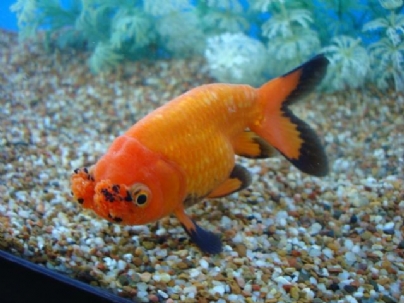Last time I ordered from Goldfish Connection, I bought a canister of color food, then almost immediately read that color food can cause color change in some fish-chocolate and black particularly. So I haven't been feeding it to my chocolate ranchu, but have been handfeeding a pinch a couple times a week to my calico ryukin and red cap.
I now have four fish. I got a new arrival yesterday, now in QT. Prawn is the most intense red/orange fish I have ever seen-photos simply don't do it justice. Is this a fish that would benefit from an occasional pinch of color food? Prawn is a red eggfish with pom poms. There is a little black on the body and fins and pom poms. I expect it will eventually lose the black, which would be a pity, but mostly I want to keep that intense red.
Having read that sunlight helps keep color, I wondered if sunlight coming in through a window and hitting the tank for a half hour or so a day would be of help? I normally keep the window curtained to prevent the light from heating up the room in summer. The window is across the room from the tank, so it wouldn't heat up the tank, but would the light do any good? But glass doesn't let uv in and is it the uv that helps with color retention?
I also wondered if full spectrum light, like an Ott light would help with color retention?
And I wonder what would happen if you moved the fish to an outdoor pond for a short vacation during early or late summer, when it isn't so hot. How much sun, for how long would be useful for strengthening color. And how much can sunlight trump genetics?

I now have four fish. I got a new arrival yesterday, now in QT. Prawn is the most intense red/orange fish I have ever seen-photos simply don't do it justice. Is this a fish that would benefit from an occasional pinch of color food? Prawn is a red eggfish with pom poms. There is a little black on the body and fins and pom poms. I expect it will eventually lose the black, which would be a pity, but mostly I want to keep that intense red.
Having read that sunlight helps keep color, I wondered if sunlight coming in through a window and hitting the tank for a half hour or so a day would be of help? I normally keep the window curtained to prevent the light from heating up the room in summer. The window is across the room from the tank, so it wouldn't heat up the tank, but would the light do any good? But glass doesn't let uv in and is it the uv that helps with color retention?
I also wondered if full spectrum light, like an Ott light would help with color retention?
And I wonder what would happen if you moved the fish to an outdoor pond for a short vacation during early or late summer, when it isn't so hot. How much sun, for how long would be useful for strengthening color. And how much can sunlight trump genetics?



